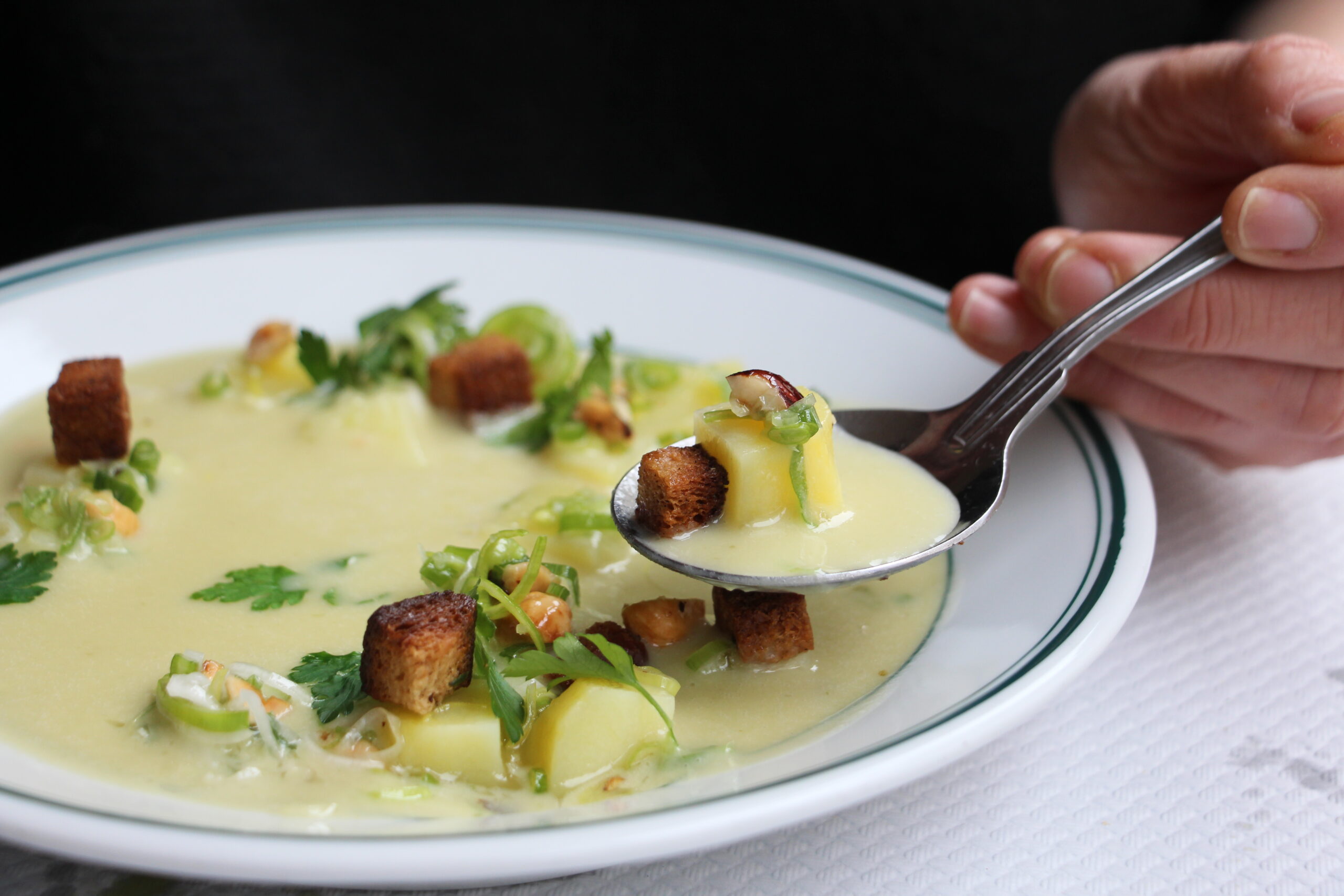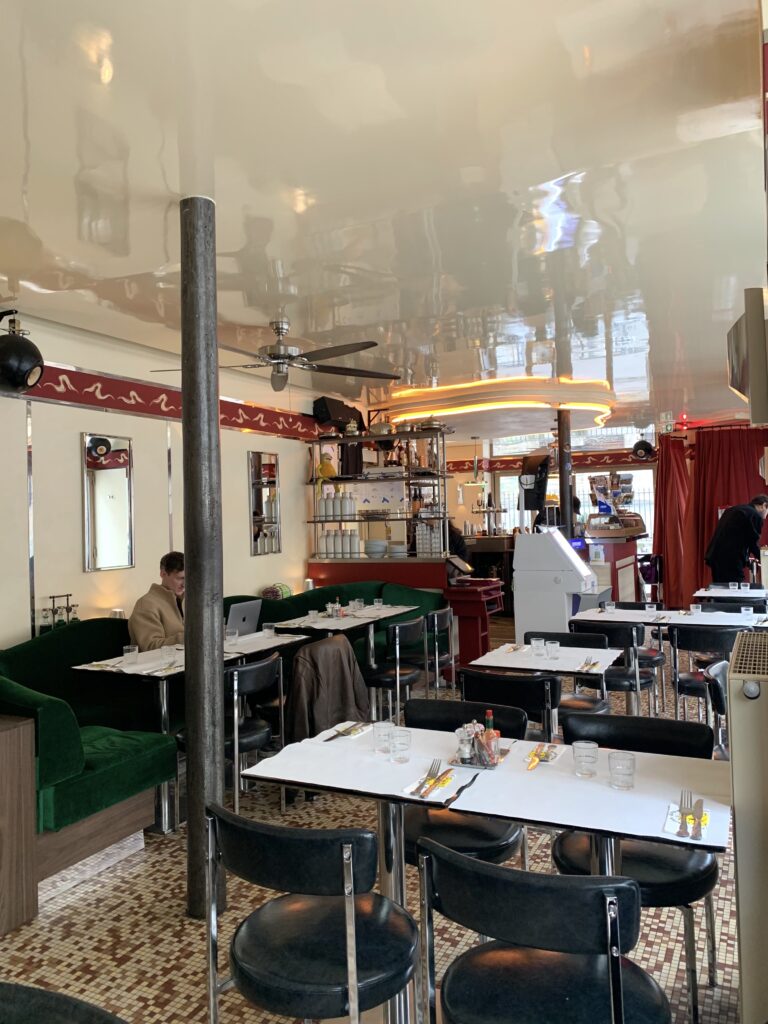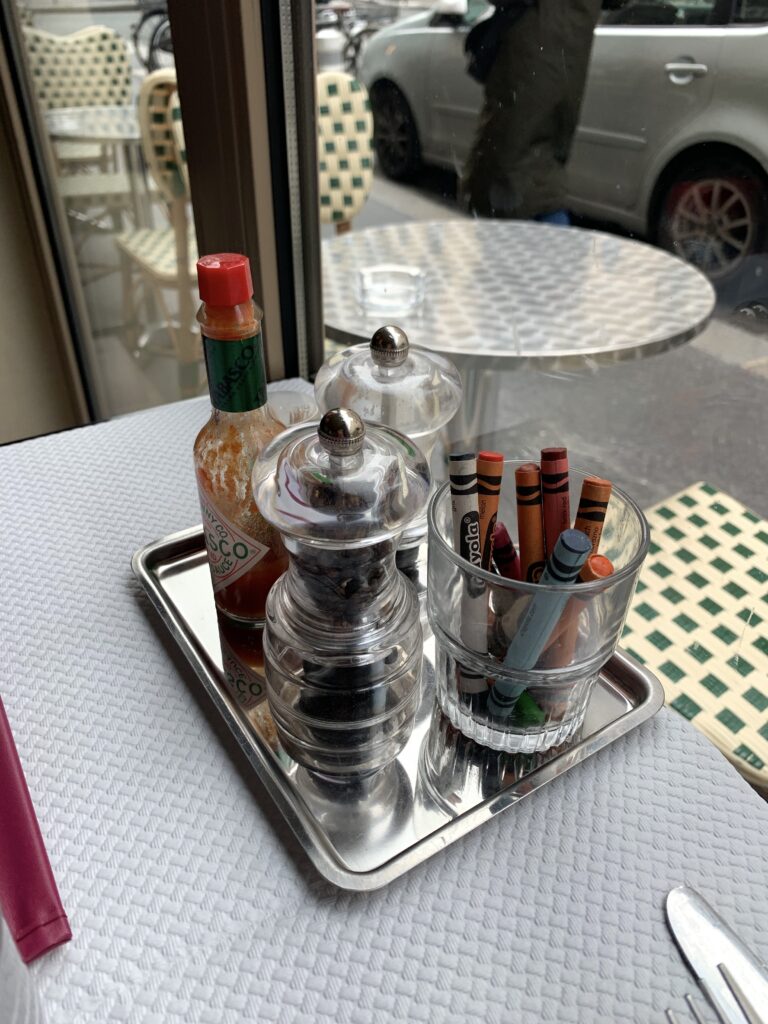It seems that every few months, a new 11th arrondissement restaurant becomes the hipster foodie darling: after Café du Coin, it was le Goncourt, and of late, le Cornichon has held that title. A neo-rade, this play on a French-style dive has revitalized the betting café category known as the PMU with a short-and-sweet, quality-driven menu of homestyle French classics.
I’ve enjoyed the other members of this category without feeling a need to return to them again and again. But for me, le Cornichon shines where others have merely flickered thanks to both its utter adherence to classic café codes and its attention to customer experience.
Le Cornichon is open from 9am to 2am (from 10am on Saturdays), with a lunchtime menu served from noon to 3pm and a dinner menu served from 6pm onwards. One can reserve at lunch but not at dinner; I misunderstood and popped in at noon sans résa but was nevertheless welcomed and offered a lovely table by one of the expansive windows lining the entirety of the space.
Le Cornichon marries the best of the vibes of both diner and café. A massive bar dominates the dining room, and the old-school mosaic tiled floor, flipper game in the corner, and antique signage advertising betting games and Kanterbräu beer are right out of any classic French café. That said, the chairs gleam with chrome, there’s Tabasco and crayons on every paper-tableclothed table, and many dishes are served on the green-bordered white ceramic plates I associate with the Greek diners of my New York City childhood.
Much like at Le Mansart, a similarly vibey spot in Montmartre, the daytime menu hews quite closely to café codes, while evening invites a medley of shared small plates comprised of a few of the daytime à la carte offerings supplemented with seasonal additions like duck heart brochettes or courgettes with pesto and ratatouille. Eleven-euro cocktails and a nice selection of wines by the glass or the bottle, many of which are natural, join the refrain we in Paris are beginning to know well.
I chose to visit first at lunchtime, and I get the sense that this is where le Cornichon truly sings its own tune. An à la carte menu is joined by a semainier, a three-course, no-choice prix fixe (19 euros for two courses, 22 for three) with different offerings depending on the day of the week. Some choices gave me major flashbacks to my year in French middle school, like a hamburger patty with mashed potatoes, carottes râpées, or breaded and fried fish. A la carte, you’ll find charcuterie (8-12 euros per portion, depending on what you choose), appetizers like Dubarry-style scallops (22) or bulots (12 euro for 6), as well as mains like rigatoni with garlic and sage butter (17), beef Rossini (35) or a trout in beurre blanc to share (32 euro per person).
We opted to do a bit of both.
On a Wednesday, the appetizer of the day was nominally a Brussels sprout salad, but I was not prepared for the beauty of this particular dish, both visually and gustatorily. Roasted Brussels sprout halves and raw leaves were generously doused in a salsa macha-esque sesame dressing. Settled atop a generous yogurt base, this dish was moreish in all the best ways – and made all the tastier when accompanied by excellent baguette from nearby Urban Bakery.
Our à la carte choice was almost as pretty. Leeks mimosa (14) were garnished with egg yolk and white as well as a pickled shallot condiment, fat capers, and loads of crispy croutons and fresh herbs. The leeks themselves were still al dente (thankfully, a rather intimidating knife slid through them like butter). The choice to cook them in this way showcased their freshness and flavor. Unfortunately, while the separation of white and yolk certainly made for a pretty plate, it led to a slightly imbalanced eating experience, but other than that, this dish was pretty perfect.
The main of the day, a veal blanquette, was new to the menu, and when I headed to the bar to pay, one of the proprietors asked me eagerly – almost anxiously – how it was. My effusive praise was far from a put-on.
This classic stew is made with veal in a thickened white gravy often seasoned with a touch of lemon and served with rice. This version blew many of the others I’ve had out of the water. The differences were subtle: a bit more generosity with the perfectly al dente carrot and celery, a base of rice pilaf that soaked up all that rich sauce to take on the creamy texture of risotto. The meat wasn’t the tenderest I’ve ever had, but it was far from tough, and the flavors here were positively on point.
Vegetarians don’t have too much to choose from on this menu, and indeed, a two-top near us decided to head somewhere else after perusing the options. What they might not have realized is that Le Cornichon actually does make concessions to vegetarian diners – and not one of them includes coquillettes.
At lunchtime, a vegetarian diner can order the prix fixe with a more copious portion of either the leek mimosa or a vichyssoise soup as a main. A la carte, the ten-euro vichyssoise is still generously portioned, and it was perhaps the prettiest dish of them all, the thick soup poured tableside from an old-fashioned silver pitcher.
Often, I find this classic of French cuisine suffers on two counts: it’s textureless, and it’s too rich, with cooks relying on cream to achieve the sought-after velouté texture. This one was nothing of the sort. Not only did the accoutrements of firm cubes of potato, croutons, hazelnuts, leeks, parsley, and green onion add loads of welcome texture, but the soup had clearly been cooked with care so that all of the sweetness of the leek and potato needed just a touch of cream to bring out their best. It was a touch oversalted, but that’s my only quibble.
The semainier includes a dessert, which, like the appetizer and main, varies by the day. Chocolate mousse, Moroccan-style oranges, and crème renversée are possible options; on Wednesdays, it’s an apple-pear crumble with Borniambuc raw cream, which is also one of two à la carte dessert options joining a 15-euro cheese plate.
This is definitely an atypical crumble, with fruit cooked almost to the texture of a compote crowned with a small amount of almost cobbler-like topping. None of which is a complaint. This is comfort food at its very best, spiked with cinnamon and far from too sweet. And the generosity with that cream just serves to highlight what I love so much about this place.
I eat in a lot of old-school (and wannabe old-school) spots, and I often find myself considering what makes a place surprising or different. For me, what makes le Cornichon so great is its authenticity. You really feel the desire to bring out the best parts of an old-style café, and any touches to elevate tradition are in service, not to the ego of the chefs, but to the diner experience. More than any other neo-café or neo-rade I’ve eaten at, le Cornichon feels like the kind of place where a geezer accustomed to a 9am pastis and a hipster showcasing the beef fat fries for Instagram can happily coexist.
Le Cornichon – 2, rue des Goncourt, 75011










